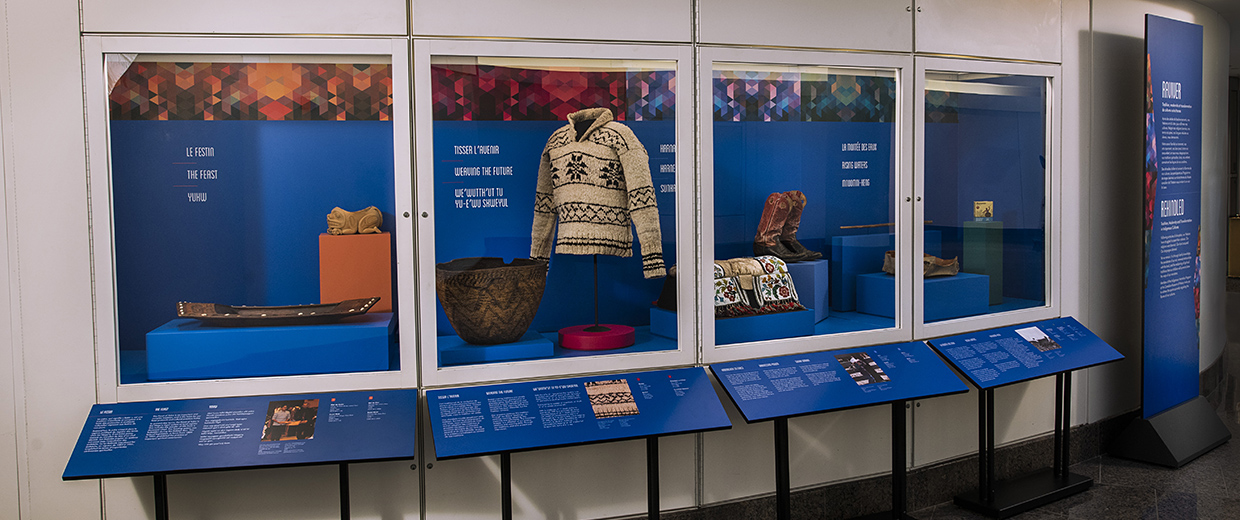Rekindled – Tradition, Modernity and Transformation in Indigenous Cultures
Special Display
Sparks are reigniting the flames of our cultures. Participants in the 2019 Indigenous Internship Program at the Canadian Museum of History invite you to witness the light.
Following centuries of disruption, our Nations have struggled to assert their cultures. Our religions were banned. Our land occupied. Our languages silenced. Yet we remain. It is through family knowledge, the persistence of our art, renewed relationships with the land, and the reclaiming of spiritual traditions that our children will come to know the ways of our ancestors.
The special display Rekindled – Tradition, Modernity and Transformation in Indigenous Cultures is a project of the interns in the 2019 Indigenous Internship Program at the Canadian Museum of History.
Testimonials
Sarah Monnier
Manoomin, or wild rice, is a big part of my life. Many dishes made with wild rice were shared at our special occasion meals, such as potlucks, family dinners and feasts. For many Indigenous people living away in cities, traditional food provides a form of comfort and security. By highlighting wild rice and the traditional tools used in its harvesting, I hoped to show its continued, yet changing, cultural meaning. I plan to pass on the importance of wild rice to future generations.
This project is the culmination of the work of the 2019–2020 Indigenous Internship Program interns to create an exhibit that used all the different museum skills learned from the program. The project has allowed community members to engage with, reflect on and present unique stories from our communities. Hopefully, this collaborative storytelling effort will continue forward into new Indigenous internship projects.
Skylar-James Wall
In choosing the belongings to be displayed, I sought to show the adaptability of my people. Horses are not from the North American prairies, but we embraced them as part of our lives as if they had been with us since time immemorial. The saddle is a European design, but it has been decorated in the same style as our own clothing. Beads obtained through trade are used to recreate designs once made by dyed quills. Every object of European origin that entered our communities was readapted to suit our livelihoods. Our culture was not interrupted by the arrival of Europeans but found ways to continue on. The boots serve as a more modern example of this process. Even through land theft and the disruption of our traditional ways, we continue to find ways to preserve our relationship with the horse two centuries later.
Kaitlyn Stephens
The objects I chose were a feast dish from 1905 or earlier and a feast bowl from 1973. Ts’ak’, or feast bowl, is generally used for holding financial contributions during a feast, which is part of the process of settling an estate of a deceased person in the Nisga’a way, including settling debts related to funeral and settlement feast expenses. But in this context, the ts’ak’ is more than just a bowl, it is symbolic of a receptacle containing all Wilp (house/family) property — both tangible and intangible. The symbolism underlies the meaning of Ayuuk: Nisga’a Law.
I think it is important to highlight the continuity of traditions because it is the basis of our cultures, customs, protocols and values that help form the structure and foundations of our societies. Also, our connection to culture and traditions helps us to understand our cultural identity and gives us a sense of belonging.
This exhibit is different from usual museum exhibits. It is unique in that it comprises four different Indigenous groups that focus on one theme — cultural continuity. And not only do we focus on one theme, but we also have our own sections that give a glimpse of our own community’s perspective. I also think this exhibit is unique in that, in our individual sections, we included our own respective languages, which gives the idea that cultural traditions are ongoing and a big part of that is language.
Shaun Canute
I am grateful for the opportunity to work alongside my fellow interns and Canadian Museum of History staff. Despite having enumerable objects to choose from, what seemed to remedy our wonderment was the simple fact that we were in the same starting place with the same objectives.
The patterns that emerge are telling of our propensities and desires. Patterns in these objects are from different times and different people. The significance of this is the interconnectedness of these seemingly separate objects. Whether it is weaving, knitting, researching or writing, our methods come through.

From left to right: Gaëlle Mollen, Coordinator, Indigenous Internship Program, with the 2019 interns, Sarah Monnier, Kaitlyn Stephens, Shaun Canute and Skylar-James Wall.
Photo: IMG2020-0007-0005-Dm
Photo at top of page:
IMG2021-0152-0059-Dm
© Canadian Museum of History
